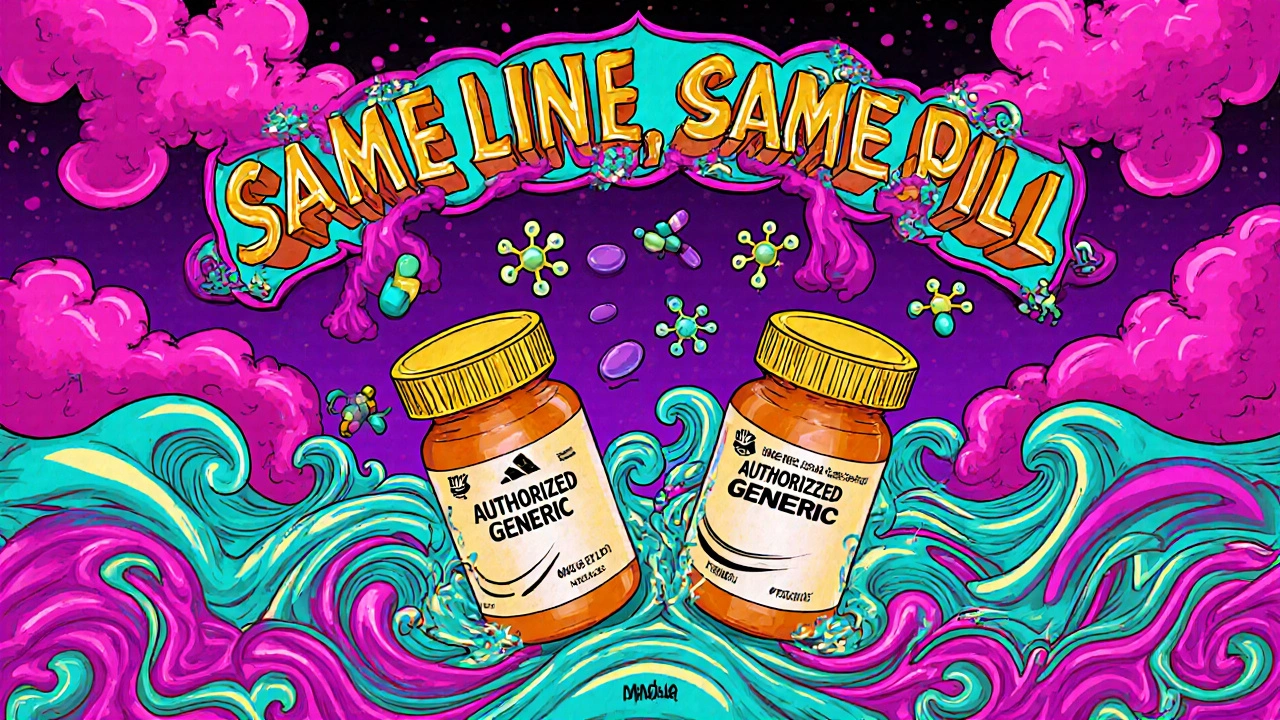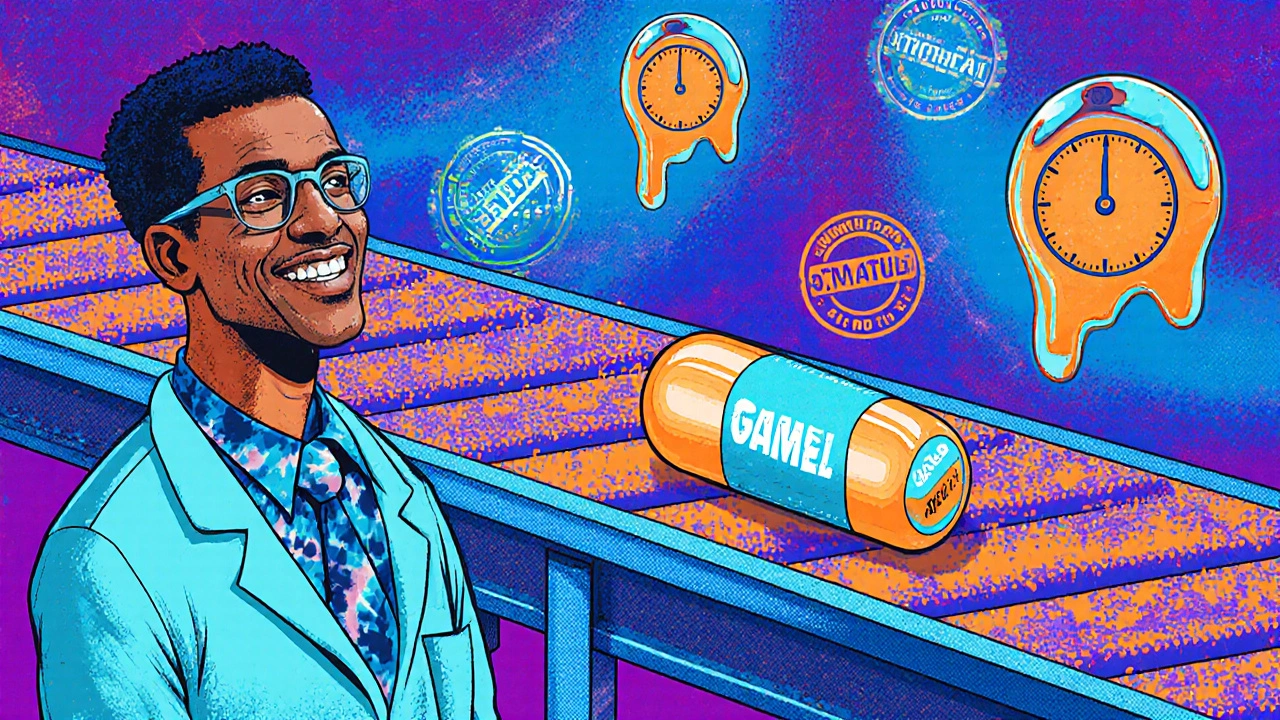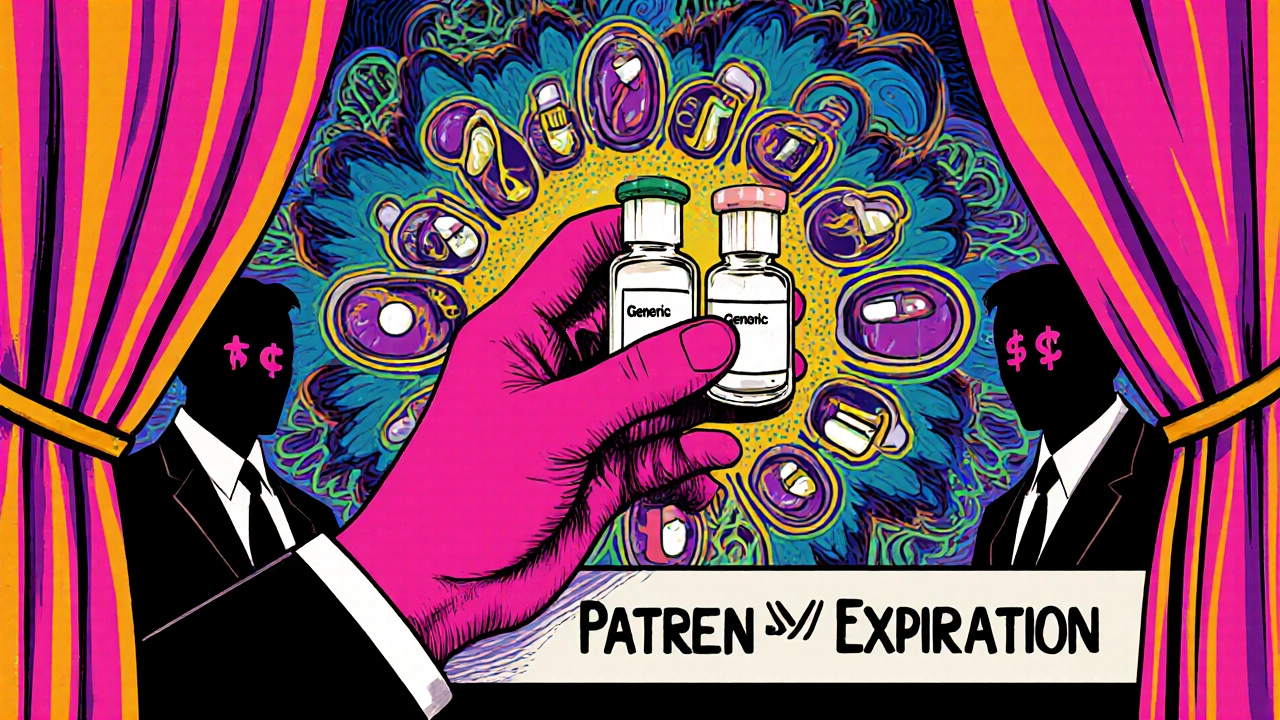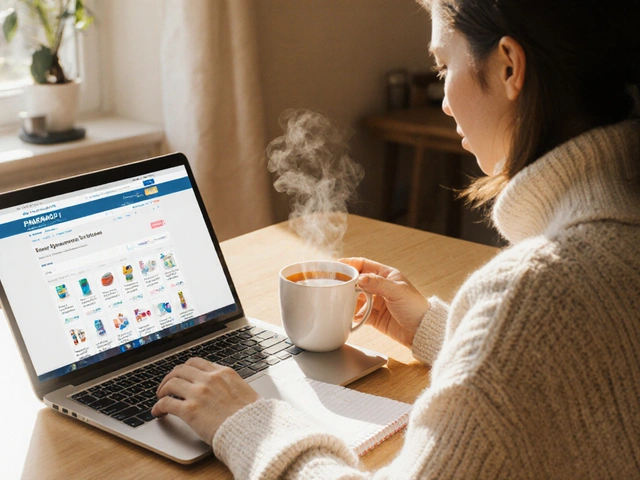
When you pick up a bottle of generic medication at the pharmacy, you might assume it’s made by a separate company, maybe even overseas, with cheaper ingredients and looser quality control. But what if the bottle in your hand was made in the exact same factory as the brand-name drug you used to pay more for? That’s the reality of authorized generics.
They’re Not What You Think
Authorized generics aren’t knockoffs. They’re not copies approved under a different application. They’re the exact same pills, capsules, or injections as the brand-name drug-same active ingredient, same dosage, same manufacturing process, same factory. The only difference? The label. No brand name. No fancy packaging. Just a plain box with the drug’s generic name and a lower price tag.This isn’t a loophole. It’s a legal pathway built into U.S. drug law since 1984 under the Hatch-Waxman Act. The original drug maker-the company that spent years and billions developing the medicine-can legally produce and sell their own drug as a generic. And they do. A lot.
Who’s Really Behind the Label?
Most people think generic drugs come from companies like Teva, Mylan, or Sandoz. But with authorized generics, the brand-name company is often the manufacturer. In fact, about 52% of authorized generics are made directly by the original innovator company under a private label. That means if you’re taking an authorized generic version of, say, Lipitor, you’re getting the exact same product Pfizer made when it was still branded.Then there’s the second group: wholly-owned subsidiaries. Pfizer’s Greenstone LLC is the biggest example. Since 1998, Greenstone has been making authorized generics of Pfizer’s drugs-over 70 of them. Same factory. Same equipment. Same quality checks. Just a different label. Same goes for AstraZeneca’s Az generici, which made the authorized generic of Nexium into a $1.2 billion-a-year product.
The third group-about 17%-are made by third-party contract manufacturers. But even then, it’s not random. The original brand company still owns the New Drug Application (NDA). That means they’re legally responsible for every pill. They pick the supplier, approve the process, and inspect the facility. If the FDA finds a problem, it’s the brand company that gets called out, not the contractor.
Same Factory. Same Line. Same Quality
Here’s the key detail most people miss: 68% of authorized generics are made in the exact same facility as the brand-name version. Compare that to traditional generics-only 12% are made using the same processes as the original drug. That’s not a small difference. It means the authorized generic isn’t just similar. It’s identical.Take the case of Comtan, a Parkinson’s drug made by Novartis. When they launched the authorized generic, they didn’t switch factories or change how they made the active ingredient. They didn’t cut corners on purification or testing. They just swapped the label. Same glass vials. Same lyophilization process. Same batch numbers. Same quality control.
Even packaging matters. When Teva made an authorized generic of Copaxone, they had to keep the exact same glass vials and freeze-drying process because even tiny changes could affect how the drug works in the body. That’s not something you’d see with a typical generic. Most generic makers use cheaper vials, different fillers, or faster drying methods to save money. Authorized generics can’t.

Why Do Brand Companies Do This?
It sounds counterintuitive. Why would a company that just spent $2 billion developing a drug turn around and sell a cheaper version of it? The answer is strategy.When a patent is about to expire, generic competitors start lining up. The brand company can either watch their sales drop 80% overnight-or they can launch their own generic first. By doing so, they capture a big chunk of the generic market before anyone else gets in. It’s a way to control the transition.
Some experts call this smart business. Dr. Dan Leonard from the FDA’s GDUFA committee said it lets brand companies compete with generics while keeping quality in-house. Others, like Harvard’s Dr. Aaron Kesselheim, argue it’s a tactic to delay real competition. If you’re the only generic on the market, and it’s made by the brand, why would a cheaper, independent generic bother entering? The price stays higher than it should.
The FDA acknowledges both sides. They confirm authorized generics meet the same standards as brand-name drugs. But they also note the potential for market distortion. That’s why, starting in 2024, they’re requiring manufacturers to disclose whether the authorized generic is made in the same facility as the brand. Transparency is the new rule.
Where Are They Most Common?
You won’t find authorized generics in every drug category. They’re most common where the original drug maker has strong market control and high profit margins. Cardiovascular drugs lead the pack-28% of all authorized generics. That includes blood pressure meds, cholesterol drugs, and anticoagulants. Central nervous system drugs come second (22%), like antidepressants, anti-seizure meds, and Parkinson’s treatments. Metabolic drugs like diabetes pills make up 18%.And the trend is growing. In 2018, authorized generics made up 6.1% of the U.S. generic market. By 2022, that jumped to 9.2%. Annual sales hit $4.7 billion. That’s not small change. And with over $127 billion in brand-name drugs set to lose patent protection by 2030, the number of authorized generics is expected to rise another 15-20% by 2025.

The Humira Effect
One of the biggest upcoming cases is Humira, the autoimmune drug that once held the title of the world’s best-selling drug. AbbVie, the maker, knew its patent was ending. So they set up Soliris Generics-a subsidiary-to make the authorized generic. They didn’t wait. They planned years ahead. When the patent expires, the authorized generic will be ready to go on day one. No delay. No gap. Just a lower price, same drug, same factory.This is becoming the playbook. Big pharma doesn’t just wait for generics to come in. They build their own.
What This Means for You
If you’re taking a generic drug and wondering if it’s as good as the brand, the answer for authorized generics is simple: yes. It’s the same thing. No compromise. No hidden differences. The FDA says so. The manufacturing data backs it up.But here’s the catch: you might not know you’re taking one. Pharmacies don’t always tell you. Insurance plans don’t always differentiate. So if you want to be sure, ask your pharmacist: “Is this an authorized generic?” If they say yes, you’re getting the exact same product as the brand-just without the name on the box.
And if you’re paying less for it? That’s a win. Even if the brand company made it.






Cynthia Springer
November 27, 2025 AT 10:35I had no idea authorized generics were the exact same pills as the brand-name drugs. I always assumed generics were cheaper because they cut corners. This changes how I look at my prescriptions.
Just checked my Lipitor bottle-yep, it says ‘atorvastatin’ on the label. Now I’m wondering if my doctor knows this too.
Brittany Medley
November 29, 2025 AT 09:36Wow. This is one of those things that should be on every pharmacy label. Seriously. If you’re getting the same drug, same factory, same QC-why hide it? I’ve been taking generic metformin for years, and now I’m going to ask my pharmacist point-blank: ‘Is this authorized?’
Also, the Humira playbook? Genius. And kind of terrifying. Pharma’s playing 4D chess while we’re still trying to figure out if ‘generic’ means ‘good’.
JAY OKE
November 30, 2025 AT 22:21So if I’m taking an authorized generic, I’m basically paying less for the same thing Big Pharma made? That’s wild. I thought generics were for people who couldn’t afford the brand. Turns out, it’s just a label game.
Still, I’ll take the savings. Even if it’s Pfizer in disguise.
Amanda Wong
December 1, 2025 AT 13:55This is a scam dressed up as transparency. The FDA ‘acknowledges both sides’? That’s code for ‘we’re too weak to stop it.’
Brand companies create their own generics to crush real competitors. They control the supply, the pricing, the narrative. And now they’re forcing disclosure? Too little, too late. This isn’t consumer protection-it’s damage control.
Deborah Williams
December 2, 2025 AT 09:31It’s almost poetic, isn’t it? The same hands that priced a pill at $10,000 because ‘research costs’ are now selling the exact same pill for $5 because… ‘market dynamics.’
We’re told to trust science, trust medicine, trust the system. But when the system is the same entity that invented the problem and then sold you the solution-what are we really trusting?
Maybe the real question isn’t ‘who made this?’
It’s ‘who’s allowed to profit from our bodies?’
Kaushik Das
December 2, 2025 AT 13:54Man, this is wild in India too-we get tons of generics, but rarely know if they're from the original maker. Here, it's mostly Teva or Dr. Reddy's, but the idea that Pfizer makes its own generic? That’s next-level strategy.
Still, I'm glad someone’s finally talking about this. Most folks think ‘generic’ = ‘cheap junk.’ This post flips the script. Good stuff.
Asia Roveda
December 2, 2025 AT 23:05Of course the U.S. lets pharma do this. We let them price insulin at $300 and call it ‘innovation.’ Now they make their own generics to keep profits high? Classic American capitalism: monopolize, then pretend you’re helping.
Don’t tell me ‘it’s legal.’ So is stealing if you have a lawyer.
Micaela Yarman
December 3, 2025 AT 01:20It is, indeed, a matter of considerable public interest that the regulatory framework permits originator manufacturers to produce and distribute authorized generics under private-label arrangements, thereby maintaining vertical integration within the pharmaceutical supply chain. Such a practice, while technically compliant with the Hatch-Waxman Act, raises profound questions regarding market competition, consumer autonomy, and the ethical boundaries of intellectual property exploitation.
Transparency, as mandated by the FDA beginning in 2024, is a necessary but insufficient step toward restoring public trust in pharmaceutical pricing mechanisms.